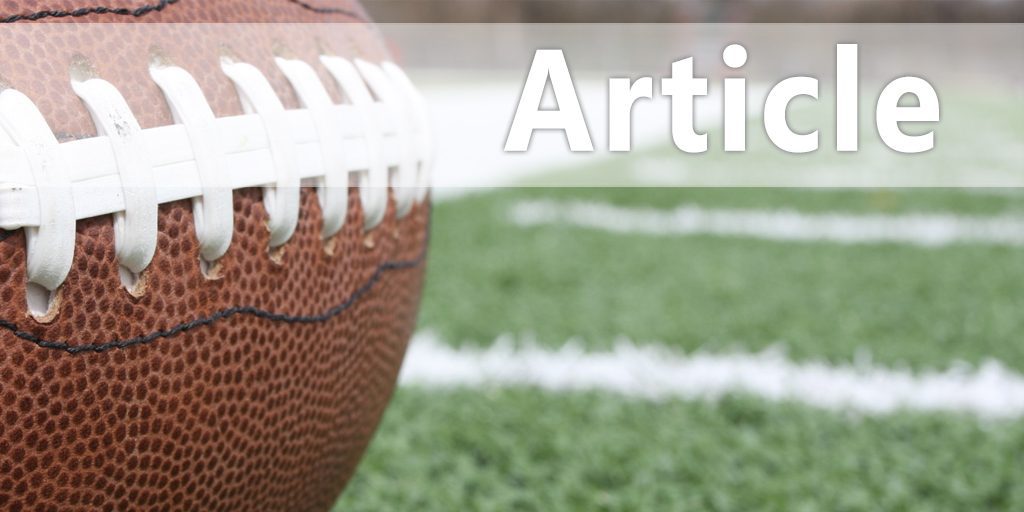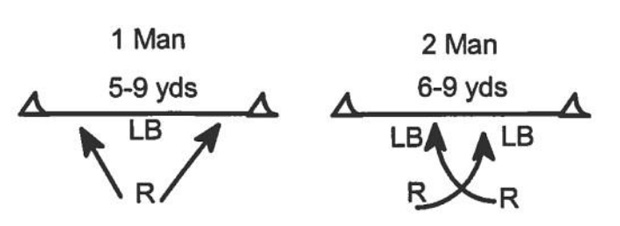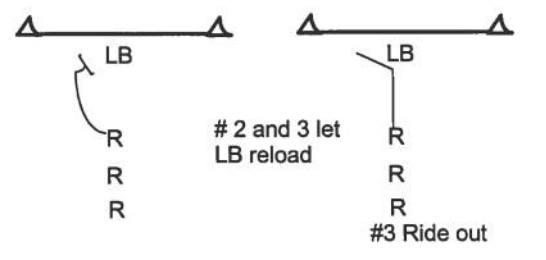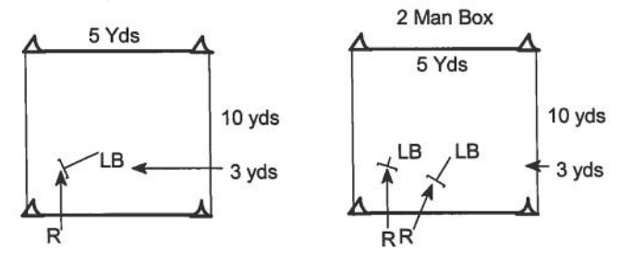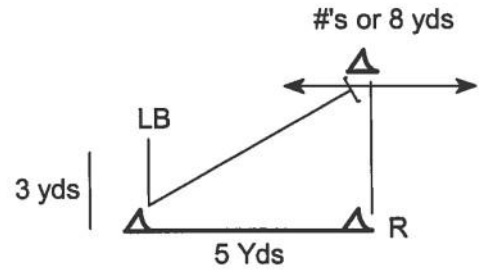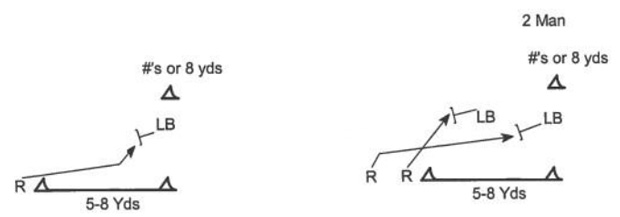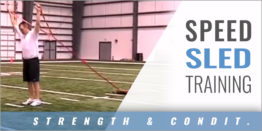| Developing Physical Linebacker Play |
| By: Scott Farison - Defensive Coordinator, Robert Morris University (PA)
Provided by: American Football Monthly
From my standpoint, the greatest compliment our defensive staff can receive is at the end of the game having the opposing coach say how hard and physical our guys played. Playing hard is something that every coach demands from their team. Playing a physical style necessarily is not. If we do not practice being physical, how can I expect my guys to come out on Saturday and play physical? We try and recruit naturally physical kids, but we all know sometimes it does not work out that way. Over the years, we have seen that the drills we have practiced have increased our physical play. While concentrating on LB play, these same drills are utilized with our defensive backs and defensive linemen. At the linebacker position, we stress that we have to be as physical with the wide receivers as we are with the offensive linemen. As linebackers, we do not want to change gears depending on who we are going up against. We teach having the same mentality if you are closing the power run or jamming a WR. From a defensive perspective, we are a gap controlled aggressive defense. Our linebackers are taught to use their eyes to gather information and react off that information. If they initially read run, they get to their gap. In the pass game, we do not drop to spots, we drop to people. It is a matchup zone concept. We rely heavily on our backers being able to locate who they need to cover and making sure that their route is not run the way it is supposed to be. We practice a ton of jam drills, as well as a ton of fit drills. We ask our players to be aggressive and ask them to be physical. They cannot worry about making mistakes because they become slow, non-physical players. We have a saying, "I am not asking you to be perfect - I am asking you to be right." If our players see something on the field and react in a football physical way, how can it be wrong? Often, we want to get on our players for doing it wrong instead of finding out why they did it that way. If they are not seeing what we are seeing, it is our job to make sure they understand where their eyes need to be. These next 5 drills are practiced at least twice a week. During camp it may be every other day. Every one of these drills has a competition component to them. To make sure we are going hard and making each other better, there is always a winner and a loser. Depending on how we are practicing, the punishments vary. Mirror Drill (Diagram 1)
Objective - To not let our opponent get past the line and score. On Field Objective - Learn to strike opponent and control where they go. Used in WR jams as well as with OL jams. DRILL A. Start with two cones five yards apart. You can change the distance, sometimes getting to nine yards. B. LB starts with heals on the line in ready position. The rabbit starts 2-3 yards in front of him. C. Rabbit has roughly 15 seconds to score as many times as he can. No use of hands or Bull Rush to start the drill. D. If a rabbit scores three times it’s over and LB loses. If LB holds the rabbit out for the 15 seconds, it is over and the rabbit loses. E. We also will do this with two LBs and two rabbits - this adds a communication element to the drill. F. Rabbits should not wait on the LB. If he can score, he should score. Remember, competition is key. G. There are times where we will let the rabbits use their hands and a bull rush. COACHING POINTS • Get feet and hands to work together along with understanding where you need to jam your opponent. You want to jam high and concentrate on the shoulders. Too many times we see hand placement low around the midsection or waist and it hinders your strength. • Footwork is key to a linebacker. This drill helps to cut down on wasted motion as well. Do not shuffle but slide. You do not want to get over extended or step in place. You never want to touch feet. You only cross feet if you are forced to run. • This drill forces your feet and hands to work together. You want to strike your opponent with optimum force. OL Rapid Fire Gap Drill - (Diagrams 2A and 2B)
Objective - Control your gap by striking three opponents in a row. On Field Objective - For middle linebackers and stacked outside backers to simulate a OL coming to the second level now while still maintaining your gap control. DRILL A. Start with two cones five yards apart. B. LB starts in the middle of the cones. Three rabbits are stacked three yards from line of scrimmage. C. LB is told prior which side is his gap to protect. D. On the command, the first rabbit comes to block the LB choosing which side which is his choice. E. Once the LB secures his gap, he reloads to center and another "GO" is given and the next rabbit goes. Do three at a time. COACHING POINTS • LB must read the block of the lineman and understand gap protection. • Emphasize quick strikes to try and gain your leverage. • Emphasize trying to stay square to the LOS. When a rip is necessary, work on quickly reestablishing your shoulders back to square. • There are times when you can have the rabbits flat out hold in prep for game- like conditions. • If a rabbit does not attempt a good block or the LB cannot gain position, they are deemed the loser. Box Drill (Diagrams 3A and 3B)
Objective - For the rabbit to cross the line. On Field Objective - Locate a WR and redirect his routes. Also aids in your man to man skills. DRILL A. Make a box with cones five yards wide and 10 yards deep. B. LB starts three yards deep in box and the rabbit can start anywhere on the line. C. On the command, the rabbit simply tries to get through the end line. D. The LBs objective is to get the rabbit out of the box or not let him get to the end line. COACHING POINTS • Similar to the mirror drill, focus on hitting the rabbit in the shoulder area while bringing your feet to keep the rabbit from gaining the line. • Blow the whistle after 10 seconds. This may go longer pending the battle. • This is one of the most competitive drills you can have at practice. • You can also do this drill with two LBs and two rabbits. Play-Action Jam Drill (Diagram 4)
Objective - For the LB to get to his target as quickly as possible and defend a pass. On Field Objective - Recover from being out of position and locating WR to redirect. DRILL A. LB starts three yards from sideline. Rabbits are on the sideline five yards away. B. Coach will break the LB downhill to the sideline. C. Coach will then raise the football simulating a QB about to pass. On this command, the rabbit takes off. D. The rabbit will run to the numbers then choose to go in or out or stop. E. On the pass command, the LB will plant and locate the rabbit. He must get to the rabbit as quickly as possible while trying to jam him. COACHING POINTS • Emphasize good foot work out of the plant and go - no wasted motion. • Use good footwork angle to where rabbit will be. • Generally first time through the drill, have rabbits go straight until jammed. • If rabbit comes inside, emphasize not letting rabbit cross your face. • When they get good at this, let the rabbits add going vertical as an option. • Make sure you do the drill to both sides. Cross Jam Drill (Diagrams 5A and 5B)
Objective - To not let the rabbit get across the field. On Field Objective - We see a lot of under and crossing routes. This drill helps our players to get in a good position and practice not letting these routes be run clean. DRILL A. Cone on the sideline and a cone at the numbers. B. LB starts in the middle of the cones facing the sideline. C. On the go, the rabbit is trying to get past the LB. The rabbit can go high or low. D. LB locates the rabbit and prevents him from getting past him. COACHING POINTS • Determine a coverage prior to the drill. • In your zone coverages you do not want to get on top of the receiver so if you miss, you miss on the low side. In man to man you do not have help over the top so if you miss, you miss on the high side. Knowing the coverage allows the LB to know where to attack and force his jam. We stress on knowing where your help is. • Do this drill with two LBs and two rabbits as well. This is great practice for cover 2 responsibilities with different route combos. • Make sure you do the drill to both sides. |
